You might not think London is the best place to look for birds, but the city is full of surprises. Ecologist Joe Beale tells us more.
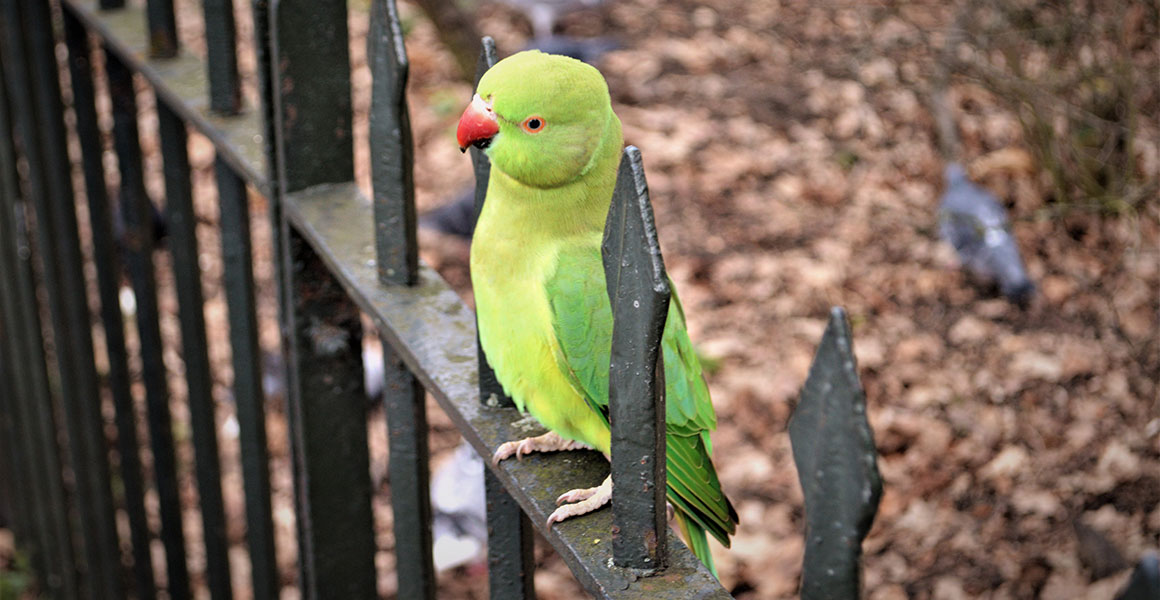
Parakeets can often be spotted in London parks, like this one perched on a Hyde Park fence. Although the birds are not native to the UK, they've made the city their home and are spreading elsewhere. Their distinctive squawks and vibrant green colour bring a touch of the exotic to our skies. © Matt Brown (CC BY 2.0), via Flickr
Over 300 species of birds have been recorded in London at different times of the year. Some are year-round residents while others migrate from as far away as Siberia or sub-Saharan Africa.
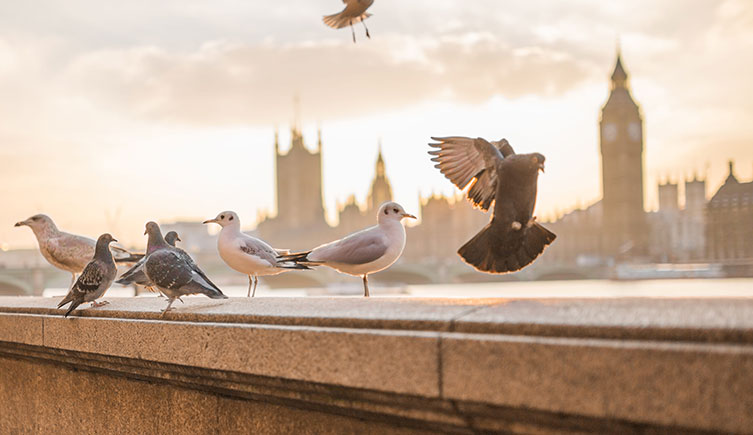
Birds are good at adapting, which enables them to thrive in our urban metropolises. They become tolerant of humans passing close to their nests, most of them aren't bothered by street lights and traffic noise only makes them sing louder.
Even peregrines and other birds of prey are becoming more common in cities, as they quietly adjust to urban life. So keep your eyes to the skies to glimpse an icon of true wildness right outside your door.

London has the second-highest urban peregrine falcon (Falco peregrinus) population in the world. Pairs are also known to nest in a number of other cities around the UK, including Chichester, Southampton, Derby, Nottingham and Sheffield. © Dave Grubb (CC BY-SA 2.0), via Flickr

London is well known for its pigeon (Columba livia) population. What is perhaps less well known is that these are the favourite prey of peregrine falcons (Falco peregrinus) resident in the capital. Image: Pexels
Though your best chances of seeing birds are in green spaces such as parks, cemeteries and wetlands, you can see them almost anywhere in London. The trick is to look up and look around.
You could even turn your sightings into science and help experts understand how wildlife is faring in our city, by taking part in The Big Garden Birdwatch in January.
The Big Garden Birdwatch top 10 spots of 2024
- House sparrow (Passer domesticus)
- Blue tit (Cyanistes caeruleus)
- Starling (Sturnus vulgaris)
- Wood pigeon (Columba palumbus)
- Blackbird (Turdus merula)
- Robin (Erithacus rubecula)
- Great tit (Parus major)
- Goldfinch (Carduelis carduelis)
- Magpie (Pica pica)
- Long-tailed tit (Aegithalos caudatus)
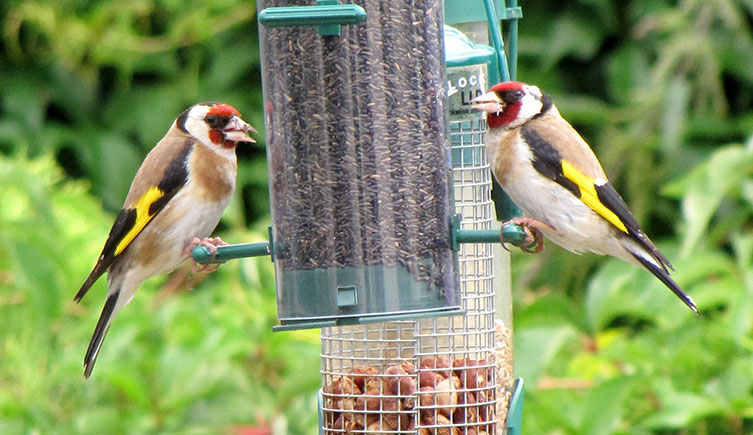

Moorhens (Gallinula chloropus) are surprisingly common on urban areas of water. They can be seen in the Museum's Wildlife Garden all year and nest on islands in the large pond. Photo by Florin Feneru.
Become an urban birder
Urban areas are excellent places to watch birds and their behaviour. The Museum's ID and Advisory Officer, Florin Feneru, provides his top tips for becoming an urban birder.
- Get to know a place close to your home, so you can visit daily if you wish. A city park is perfect, as is your own garden.
- Choose a patch that is as bird-friendly as possible, with nearby fruiting trees and bushes, such as elder, cherry, crab apple, cotoneaster, hawthorn, rowan, guelder and shrub roses. Ivy berries provide a vital, abundant food source at a time when few alternatives may be available. Wild areas filled with native plants will provide seeds and insects for many birds. Even your lawn can be a hunting ground for blackbirds, and green woodpeckers looking for ants. Put up seed, nut and fat feeders if you can.
- Practice using your binoculars so that you don't miss the action. Sit on a bench and follow the movements of one bird, such as a feral pigeon. Now look for a flying bird. Practice bringing up your binoculars and getting the bird in focus until it becomes automatic.
- Tune your ears into birdsong by visiting the same area several times over the course of a year. Learning to identify birds is easier when you are dealing with only a few species, so start by concentrating on just a few that you hear regularly. Once you've learned their songs, you won't be confused by any new voices.
- Regularly visit the same small area. This will also give you in-depth knowledge of the birds living there, and over time you will develop the skills you need to study birds anywhere. You will also increase your chance of witnessing unusual behaviour. I once saw a blackbird rubbing a wriggling newt in the leaf litter to remove its toxic skin secretions so she could swallow it!
- Once you know your birds, start recording your sightings. It's not as hard as it sounds! Just follow the same route around the same time of day and write the names of the birds you see or hear on a sheet of paper, along with the number of birds and a code for the habitat where you recorded them. Over time, you will notice patterns: distribution, movements with seasons, the times chicks fledge and more. Plus you'll have a clear record of your progress. Happy birding!

Woodpigeons (Columba palumbus) feasting on ivy berries. The berries provide an important source of food for birds in winter. © Jonathan Billinger (CC BY-SA 2.0), via geograph

Provide a range of different bird food to encourage a wide variety of species. This array of feeders has attracted a blue tit (Cyanistes caeruleus), nuthatch (Sitta europaea) and great spotted woodpecker (Dendrocopos major). © Airwolfhound (CC BY-SA 2.0), via Flickr
Birds of prey in London
Contrary to what you might expect, it's not just small birds you can see in the city: raptors are becoming more common.
Buzzards sometimes soar overhead. Red kites glide by occasionally, their forked tails giving away their identity.
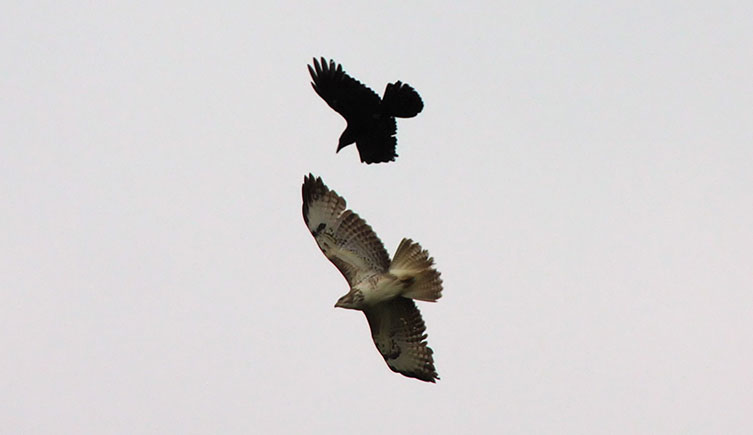
A crow (Corvus corone) mobbing a buzzard (Buteo buteo). This harassment is intended to drive the larger bird away. © Tim Felce (CC BY-SA 2.0), via Wikimedia Commons
If you're lucky, a peregrine may put in a dramatic appearance. With a magnificent 30 or so pairs nesting in the city, London now has the second-highest urban peregrine population anywhere in the world, after New York City. But it wasn't always like this.
Return of the raptors
Thirty years ago, seeing any of these impressive raptors in the capital this regularly would have been unthinkable. Red kites were still confined to Wales, buzzards were much scarcer in the east and peregrines had yet to re-establish themselves in London.
These birds have now largely reclaimed their historic range thanks to reduced persecution in some areas, legal protection, the removal of pesticides such as DDT from the food chain and, for the red kite, reintroduction programmes.
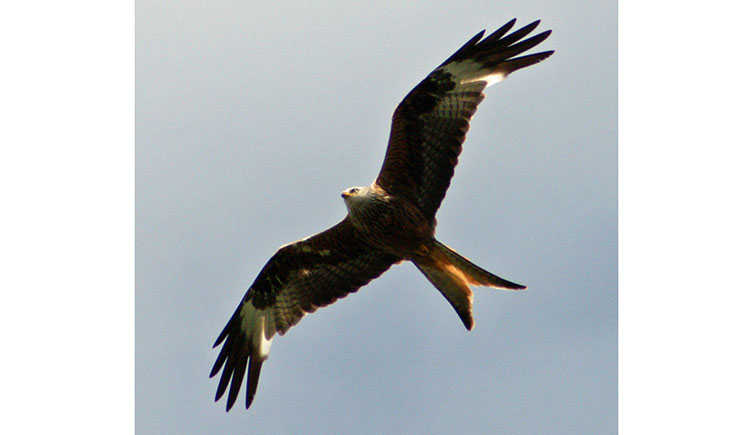
Urban cliffs and pigeon prey
Recovering peregrine populations have embraced our cities as a new habitat. Cities offer a plentiful supply of tall buildings with suitable ledges to nest on - urban cliffs - as well as abundant pigeons (their favourite prey) and, increasingly in London, the ring-necked parakeet.


Flocks of ring-necked parakeets (Psittacula krameri) can be spotted flying over London suburbs or perched in park trees. They are becoming increasingly popular as prey for peregrine falcons (Falco peregrinus). Photo by Florin Feneru.
But it's not only pigeons and parakeets that fall victim to these powerful birds of prey. In November 2018, there was a murder mystery in the Wildlife Garden when the body of a fieldfare was found on the path. It was presumed that a peregrine had caught it, possibly at night, then landed on the craggy Waterhouse building and dropped the remains to the ground.
Extended hunting hours
Peregrines are increasingly using urban light pollution to help them catch migrating birds at night. The lights illuminate the flying birds from below just enough for the sharp-eyed falcons to seize their opportunity. In this way, urban lighting is actually giving peregrines an advantage.
Unfortunately, light pollution affects many other birds negatively, in particular migrants travelling at night. Woodcocks, for example, are shy woodland waders that arrive in the UK in late autumn from northern Europe and Scandinavia. They are easily disorientated by urban lighting and sometimes crash into buildings.

An injured woodcock (Scolopax rusticola). Urban light pollution can disorient these birds as they migrate and cause them to crash into buildings. © N p holmes (CC BY-SA 3.0), via Wikimedia Commons
Winter visitors
When winter is just around the corner, cold winds blow in a host of exciting avian visitors to our Wildlife Garden, most of which are on migration.
Winter thrushes
A flock of redwings, comprising up to 30 birds, often overwinters in the garden. The first of these beautiful, orange-flanked thrushes fly in from northern Europe or Scandinavia in October or November. They rummage for invertebrates in the leaf litter and feast on holly berries.

A fieldfare (Turdus pilaris) and redwing (Turdus iliacus) feasting on berries © Mickeboy69 (CC BY-SA 3.0), via Wikimedia Commons
Infrequent visitors
A spell of bitterly cold weather and frozen ground will drive many birds to seek new feeding areas. It's at this time that different birds can turn up in our garden, such as a pair of mistle thrushes seen feasting on our juniper berries.
In September 2018, the high-pitched song of one of Britain's smallest birds, the firecrest, was heard here. Some lucky visitors even saw it feed. Its equally tiny cousin, the goldcrest, regularly winters in the Museum's garden.

Firecrests (Regulus ignicapilla), pictured, compete with goldcrests (Regulus regulus) for the title of Britain's smallest bird. Puffed up against the cold they are still smaller than a tennis ball, and about a tenth of the weight. © Jacob Arnold (CC BY 2.0), via Wikimedia Commons
Tired migrants
Many birds migrate during the autumn and spring months, and the Wildlife Garden offers these weary travellers the chance to rest and feed during their long journeys.
In October, birds include chiffchaffs, which sing from the trees and shrubs on their way to the Mediterranean region.
In spring, we've also seen a reed warbler, a common whitethroat and a lesser whitethroat singing its dry rattle song. All three of these species feed in our garden before travelling onto their breeding grounds.

Chiffchaffs (Phylloscopus collybita) can be seen in UK parks and large gardens all year round, but most arrive in early spring and depart for the Mediterranean in autumn. Recently, increasing numbers have been over-wintering. Image: Kathy2408 via Pixabay
Did you know?
During winter, we survey and collect old nests that birds would not use again. The invertebrates that live in the nests are identified by the Museum's experts to increase our knowledge of the Wildlife Garden's biodiversity.
Go wild in the city
If you're in the UK and are having trouble identifying a bird, you can send your photos to the Museum's Identification and Advisory Service. Providing details of where and when you spotted the bird will help.
Anyone can contribute to research and conservation by posting their observations to databases such as iNaturalist.
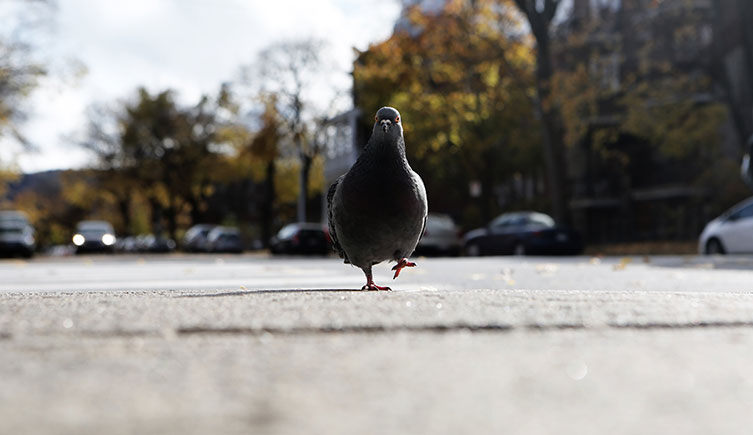
Members' magazine
A version of this article originally appeared in the October 2019 issue of the Museum's Members' magazine, evolve.
More about urban birds
- Learn about British garden birds
- Help birds in your garden by making a feeder
- Find out how to take part in the RSPB's Big Garden Birdwatch
More about urban peregrines

British wildlife
Find out about the plants and animals that make the UK home.
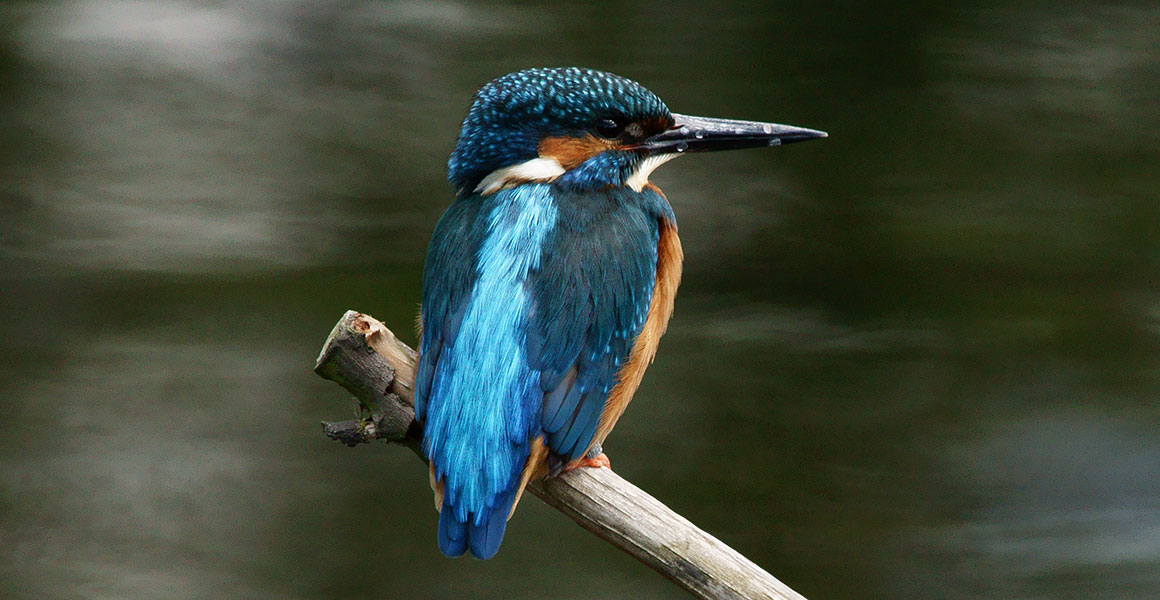



Don't miss a thing
Receive email updates about our news, science, exhibitions, events, products, services and fundraising activities. We may occasionally include third-party content from our corporate partners and other museums. We will not share your personal details with these third parties. You must be over the age of 13. Privacy notice.
Follow us on social media